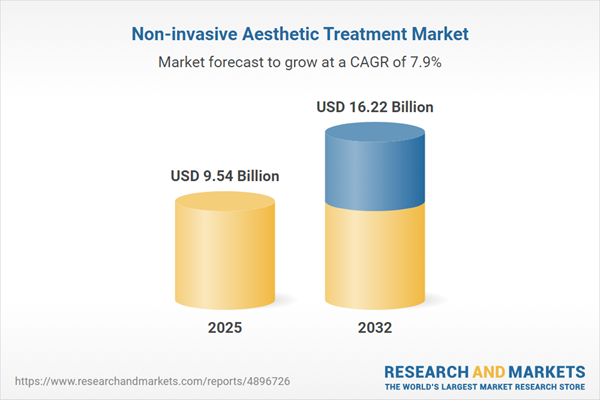Speak directly to the analyst to clarify any post sales queries you may have.
The non-invasive aesthetic treatment market is evolving, shaped by technological innovation, robust patient demand, and increasingly sophisticated care delivery. Senior decision-makers need accurate insights to navigate new possibilities and address the strategic complexities transforming this dynamic industry.
Market Snapshot: Non-invasive Aesthetic Treatment Market
The global non-invasive aesthetic treatment market is experiencing steady expansion, growing from USD 8.86 billion in 2024 to USD 9.54 billion in 2025. The market is projected to reach USD 16.22 billion by 2032, driven by a compound annual growth rate of 7.85%. This sustained momentum results from rising demand among aging populations seeking minimally disruptive procedures and a wider acceptance of aesthetic care across demographics. Strategic investments in advanced technology, diverse clinical portfolios from providers, and regional market integration by leading device manufacturers further accelerate adoption. As a result, providers are increasingly able to offer a broader spectrum of non-invasive solutions tailored to patient expectations in both developed and emerging regions.
Scope & Segmentation of the Non-invasive Aesthetic Treatment Market
This comprehensive report equips executive teams with actionable segmentation and a clear view of market structure. Defined categories allow organizations to align product strategies, strengthen regional positioning, and identify new growth areas as the sector matures.
- Treatment Types: Includes cryolipolysis, energy-based therapies (intense pulsed light, lasers—fractionated and non-fractionated), radiofrequency, ultrasound systems, and injectables. Focused attention is given to botulinum toxin types A and B, plus advanced dermal fillers such as hyaluronic acid, calcium hydroxyapatite, poly L-lactic acid, and polymethyl methacrylate. The segment also reviews evolving skin tightening procedures.
- End User Categories: Dermatology clinics, general hospitals, medical aesthetics clinics, and medical spas. Each facility type is analyzed to illustrate differing operational models, patient experience priorities, and implications for care delivery.
- Distribution Channels: Direct sales, hospital pharmacies, retail pharmacies, online pharmacies, e-commerce platforms, and official manufacturer websites. The diversity of distribution methods highlights how products reach practitioners and end users efficiently.
- Regions Covered: Americas (including the US, Canada, Latin American economies), Europe, Middle East & Africa (with focus on Western, Central, Eastern Europe, and the Gulf), and Asia-Pacific. The segment offers insights into both mature healthcare markets and areas with rapid modernization, helping leaders tailor regional expansion initiatives.
- Included Companies: Analysis covers competitive strategy and product portfolios of major market participants: AbbVie Inc., Galderma S.A., Merz Pharma GmbH & Co. KGaA, Bausch Health Companies Inc., Cynosure LLC, Solta Medical Inc., Lumenis Ltd., Alma Lasers Ltd., Candela Corporation, and Cutera Inc.
Key Takeaways: Strategic Insights for Senior Decision-Makers
- Synergy between energy-based platforms and injectables is accelerating the pace of innovation and enabling providers to offer increasingly customized patient solutions.
- Integration of digital consultation technologies supports a holistic approach to treatment planning, improving patient satisfaction and long-term retention.
- Device interoperability alongside real-time imaging capabilities is improving workflow efficiency, driving predictable clinical outcomes.
- Adoption rates and preferred technologies differ by region, emphasizing the need for strategies aligned to local regulatory standards and evolving consumer preferences.
- Collaboration with local players and regional alliances enables manufacturers to adapt more effectively to compliance requirements and to reduce time-to-market.
- Omnichannel approaches, including teleconsultation, are expanding access, broadening reach, and supporting new models for ongoing patient engagement.
Tariff Impact: Navigating Supply Chain and Competitive Shifts
Recent adjustments in U.S. tariff frameworks have raised supply chain costs in the non-invasive aesthetic treatment sector. Stakeholders are responding by broadening their supplier networks, renegotiating contracts, and investing in local manufacturing assets. Organizations with agile inventory systems and effective tariff monitoring are better positioned to sustain operational efficiency, while those less adaptable may experience shrinking margins and fulfillment challenges. Enhancing regional production and building in supply chain flexibility are emerging as core competitive strategies in light of ongoing policy changes.
Methodology & Data Sources
This report leverages a robust methodology, including systematic reviews of regulatory documentation and clinical trial results. Supplemented by interviews with healthcare leaders and procurement specialists, as well as targeted surveys of providers and patients, these data inform analysis and scenario planning for reliable, actionable results.
Why This Report Matters
- Delivers segmentation and competitive insights to help leadership teams assess market opportunities and refine investments in the non-invasive aesthetic treatment market.
- Guides better supply chain and compliance management within a rapidly evolving global landscape, improving long-term operational agility.
- Supports evidence-based decisions across R&D, marketing, and procurement by clarifying pivotal technology and regional adoption trends.
Conclusion
Navigating the non-invasive aesthetic treatment market requires responsive, informed strategies. By leveraging clear segmentation and real-time data, organizations can capture new opportunities, adapt to industry changes, and sustain growth.
Additional Product Information:
- Purchase of this report includes 1 year online access with quarterly updates.
- This report can be updated on request. Please contact our Customer Experience team using the Ask a Question widget on our website.
Table of Contents
3. Executive Summary
4. Market Overview
7. Cumulative Impact of Artificial Intelligence 2025
List of Figures
Samples

LOADING...
Companies Mentioned
The key companies profiled in this Non-invasive Aesthetic Treatment market report include:- AbbVie Inc.
- Galderma S.A.
- Merz Pharma GmbH & Co. KGaA
- Bausch Health Companies Inc.
- Cynosure, LLC
- Solta Medical, Inc.
- Lumenis Ltd.
- Alma Lasers Ltd.
- Candela Corporation
- Cutera, Inc.
Table Information
| Report Attribute | Details |
|---|---|
| No. of Pages | 196 |
| Published | October 2025 |
| Forecast Period | 2025 - 2032 |
| Estimated Market Value ( USD | $ 9.54 Billion |
| Forecasted Market Value ( USD | $ 16.22 Billion |
| Compound Annual Growth Rate | 7.8% |
| Regions Covered | Global |
| No. of Companies Mentioned | 11 |









